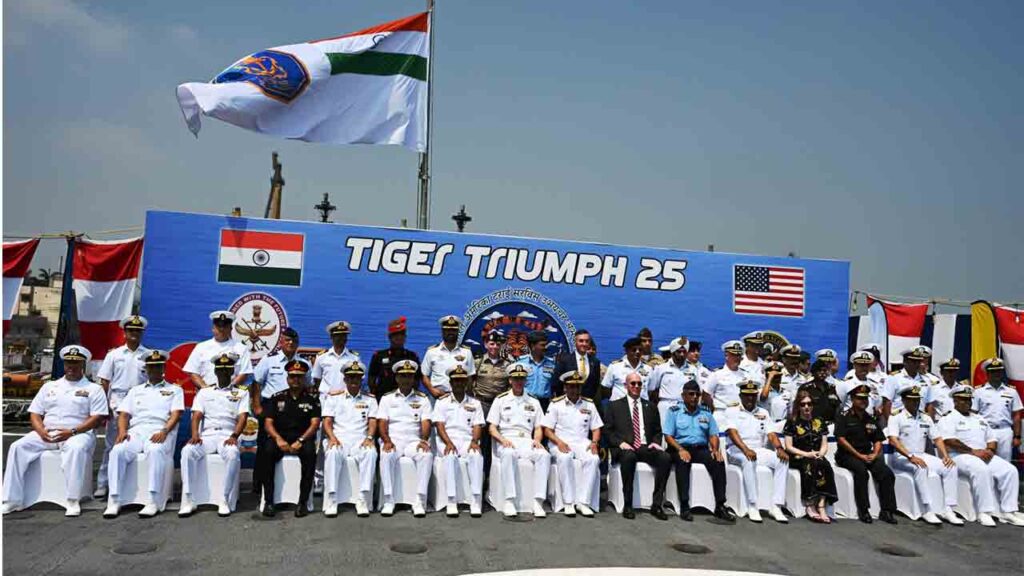“Tiger Triumph” Exercise Enhances India-U.S. Military Cooperation

The “Tiger Triumph” exercise, a joint military training program between India and the United States, continues to solidify the defense and security ties between the two nations. Launched in 2019, this exercise has become a key pillar in the growing defense cooperation between India and the U.S. Over the years, “Tiger Triumph” has evolved into a critical event aimed at improving interoperability, strategic coordination, and mutual understanding between the armed forces of the two countries. The exercise also reflects the broader geopolitical and defense alignment between India and the United States in the Indo-Pacific region, which has become increasingly important due to rising security challenges.
The Significance of “Tiger Triumph”
The “Tiger Triumph” exercise is primarily focused on joint humanitarian assistance and disaster relief (HADR) operations. This focus on non-combat operations serves to strengthen the ability of both nations’ militaries to respond to regional emergencies effectively, such as natural disasters or humanitarian crises. In a region as prone to disasters as South Asia, the ability of India and the U.S. to work together on such issues is invaluable.
The exercises cover a range of scenarios, including search and rescue operations, medical evacuation, and the provision of relief supplies in the aftermath of a disaster. By training together in a coordinated environment, the armed forces of both countries can streamline their responses to real-world events and improve the efficacy of their joint efforts. Additionally, this collaboration builds trust between the two militaries, facilitating smoother operational coordination during times of need.
Broadening Defense Cooperation Between India and the U.S.
“Tiger Triumph” is part of a broader trend of expanding defense cooperation between India and the U.S. This growing collaboration is not only limited to military exercises but also includes strategic partnerships, intelligence sharing, and access to advanced defense technologies. Over the years, the two nations have signed a series of agreements, including the Lemoa (Logistics Exchange Memorandum of Agreement), COMCASA (Communications Compatibility and Security Agreement), and BECA (Basic Exchange and Cooperation Agreement), which facilitate greater military cooperation.
The participation of both Indian and American forces in exercises like “Tiger Triumph” enhances interoperability, a crucial aspect of modern military operations. The ability to work seamlessly together, especially in a multi-national coalition or in response to global security challenges, is a significant advantage for both countries.
The Role of the Indo-Pacific in India-U.S. Relations
The growing military cooperation between India and the U.S. is also driven by shared concerns in the Indo-Pacific region. The region, home to key maritime trade routes and vital global shipping lanes, has become a focal point for geopolitical competition. Rising tensions in the South China Sea, concerns over China’s growing military assertiveness, and the ongoing stability of the region have prompted both India and the U.S. to deepen their security ties.
Through exercises like “Tiger Triumph,” the two countries are not only strengthening their bilateral relationship but also sending a strong message about their shared commitment to maintaining peace and stability in the Indo-Pacific. The strategic partnership also reflects a broader desire to counterbalance China’s influence in the region and enhance the security of global maritime routes.
Humanitarian Assistance and Disaster Relief as a Bridge
While military exercises often focus on combat operations, “Tiger Triumph” distinguishes itself by its emphasis on humanitarian assistance. In a region frequently impacted by devastating natural disasters—ranging from cyclones to earthquakes—effective disaster relief operations are crucial to saving lives and alleviating human suffering. The participation of both Indian and U.S. forces in these operations builds a unique capability that is highly beneficial to regional stability.
For India, the exercise provides an opportunity to learn best practices from the U.S., which has vast experience in large-scale disaster response operations worldwide. Meanwhile, the U.S. benefits from India’s local knowledge and experience in dealing with the challenges specific to the South Asian region. The partnership also fosters greater coordination between the two militaries in non-combat scenarios, such as civil-military relations, logistics, and infrastructure support.
Expanding the Scope of “Tiger Triumph”
The scope of “Tiger Triumph” has gradually expanded since its inception. While the initial focus was largely on training and developing interoperability in humanitarian operations, the exercise now includes broader aspects of defense cooperation. The training has become more comprehensive, incorporating a variety of scenarios that could occur in the real world, such as urban search-and-rescue missions, mass casualty evacuations, and complex medical and logistical support systems.
In addition to the joint training on the ground, the exercise also provides valuable opportunities for both countries to engage in strategic dialogues. Senior military officials from both India and the U.S. regularly meet to review the outcomes of the exercise, identify areas for improvement, and discuss new avenues of cooperation.
Impact on India’s Military Modernization
For India, the “Tiger Triumph” exercise plays an important role in its military modernization efforts. The Indian Armed Forces have been undergoing significant reforms in recent years, with a focus on improving their operational readiness, enhancing technological capabilities, and strengthening relationships with strategic partners. Exercises like “Tiger Triumph” not only provide Indian forces with access to advanced U.S. military techniques but also help Indian forces incorporate new technologies and methodologies into their operations.
The collaboration with the U.S. also offers India an opportunity to access sophisticated defense technologies that can enhance its military capabilities. The ongoing transfer of technology and expertise between the two nations has the potential to strengthen India’s defense posture, both regionally and globally.
The “Tiger Triumph” exercise is a vital component of the growing defense partnership between India and the U.S. It exemplifies how military cooperation, particularly in the areas of humanitarian assistance and disaster relief, can bridge gaps between nations while also enhancing operational capabilities. With the Indo-Pacific region becoming increasingly significant in global security dynamics, the collaboration between the Indian and U.S. militaries provides a powerful signal of their shared commitment to regional peace and stability.
As the exercise continues to evolve, it will play an increasingly important role in fostering deeper ties between the two nations, furthering the integration of their defense strategies, and contributing to a more secure and resilient Indo-Pacific region. The success of “Tiger Triumph” paves the way for even greater collaboration and cooperation in the years ahead.


